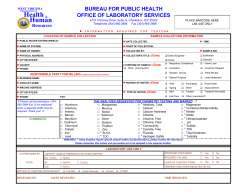
Activity Series of the Elements
SECTION 8.3 Activity Series of the Elements Teacher Notes and Answers SECTION 3 Activity Series of the Elements 1.above 2.silver, platinum, and gold Practice A.no reaction B.Cd(s) + 2HBr(aq) ⟶ CdBr2 (aq) + H2 (g) C.Mg(s) + 2H2 O(g) ⟶ Mg(OH)2(aq) + H2 (g) Review 1.The activity series is a list of elements organized according to how reactive they are. It helps predict whether a chemical reaction will occur and what the product(s) of the reaction will be. 2a.no reaction 2b.Br2 (l) + 2KI(aq) ⟶ 2KBr(aq) + I2 (s) 2c.no reaction 2d.Cd(s) + 2HCl(aq) ⟶ CdCl2 (aq) + H2 (g) 2e.Mg(s) + Co(NO3 )2(aq) ⟶ Mg(NO3 )2(aq) + Co(s) 3.According to the activity series, only cobalt will react. Copper and tin will not react because they are below nickel in the activity chart. The equation for the cobalt reaction is Co(s) + Ni(NO3 )2 (aq) ⟶ Co(NO3)2(aq) + Ni(s). C h e m i c a l E q u at i o n s a n d R e a c t i o n s 1 SECTION 8.3 Activity Series of the Elements The ability of an element to react is referred to as the element’s activity. The more readily an element reacts with other substances, the greater its activity is. For metals, greater activity means it is easier to lose electrons to form positive ions. For nonmetals, greater activity means it is easier to gain electrons to form negative ions. Key Terms activity series An activity series helps determine what substances will displace others in chemical reactions. An activity series is a list of elements organized according to the ease with which they undergo certain chemical reactions. Some chemical equations that can be written may not actually take place. Activity series are used to help predict whether certain chemical reactions will occur. The order in which the elements are listed is usually determined by single-displacement reactions. The most-active element is listed at the top of the series. This element can replace any of the elements below it in a single-displacement reaction. An element farther down can replace any element that is below it but not any above it. Critical Thinking 1. Apply In the diagram, copper replaces the silver in a silver nitrate solution. Given that this reaction occurs, is copper above or below silver on the activity series? The table on the next page shows an activity series for the elements. The information in the table can be used as a general guide for predicting reaction outcomes. Ag+ Cu H2O - NO 3 Ag + Copper metal 2 C HA P TE R 8 Cu2+ H2O + Silver nitrate solution Silver metal - NO 3 Copper nitrate solution Activity Series of the Elements Activity of metals Activity of halogen nonmetals Li F2 Rb Cl2 K Ba Sr React with cold H 2 O and acids, replacing hydrogen. React with oxygen, forming oxides. The halogens are listed in the same order as they are in the periodic table. Br2 I2 These elements are all alkali metals and alkaline-earth metals. Ca Na Mg Al Mn Zn Cr React with steam (but not cold water) and acids, replacing hydrogen. React with oxygen, forming oxides. Fe Cd Co Ni Sn Pb Do not react with water. React with acids, replacing hydrogen. React with oxygen, forming oxides. H2 Sb Bi Cu React with oxygen, forming oxides. Hg Ag Pt Au These elements are transition metals with d sublevels that are filled or nearly filled. Fairly unreactive, forming oxides only indirectly. The activity series can be used to determine if a metal will react with acids or with water. Some metals (potassium, K, for example) react vigorously with water and acids, replacing hydrogen to form new compounds. Other metals, such as zinc, Zn, replace hydrogen in acids but react with water only when it is hot enough to become steam. Nickel, Ni, will replace hydrogen in acids but will not react with steam. And gold, Au, will not react with acids or water, either as a liquid or as steam. READING CHECK 2. Name three elements that are less reactive than mercury. C h e m i c a l E q u at i o n s a n d R e a c t i o n s 3 Using the Activity Series In the activity series for metals, aluminum replaces zinc, because aluminum is listed higher on the activity series then zinc. Therefore, we would predict that the following reaction between aluminum metal and a solution of zinc chloride does occur. 2Al(s) + 3ZnCl2 (aq) ⟶ 3Zn(s) + 2AlCl3 (aq) Cobalt, however, is listed below sodium on the activity series. Therefore, cobalt cannot replace sodium in a singlereplacement reaction. Therefore, we would write the following. Co(s) + 2NaCl(aq) ⟶ no reaction SAMPLE PROBLEM Using the activity series shown in the table on the previous page, explain whether each of the possible reactions listed below will occur. For those reactions that will occur, predict what the products will be. SOLVE a. Zn(s) + H2 O(l) 50°C ? This is a reaction between a metal and water at 50°C. Zinc does not react with water when it is in liquid form. Therefore, no reaction will occur. Answer: Zn(s) + H2 O(l) b. 50°C no reaction Cd(s) + Pb(NO3 )2(aq) → ? Cadmium, Cd, is above lead, Pb, in the activity series, therefore a reaction will occur to produce lead metal and cadmium nitrate, Cd(NO3 )2. Answer: Cd(s) + Pb(NO3)2(aq) → Pb(s) + Cd(NO3 )2(aq) PRACTICE Using the activity series, predict whether each of the possible reactions listed below will occur. For the r eactions that will occur, write the products and balance the equation. 4 A. Cr(s) + H2O(l) → B. Cd(s) + HBr(aq) → C. Mg(s) + H 2 O(g) → C HA P TE R 8 SECTION 8.3 REVIEW VOCABULARY 1. What is the activity series, and how is the activity series useful in predicting chemical behavior? REVIEW 2. Based on the activity series, predict whether each of the following possible reactions will occur. For the reactions that will occur, write the products and balance the equation. a. Ni(s) + H2O(l) → b. Br2 (l) + KI(aq) → c. Au(s) + HCl(aq) → d. Cd(s) + HCl(aq) → e. Mg(s) + Co(NO3 )2 (aq) → Critical Thinking 3. PREDICTING OUTCOMES A mixture contains cobalt metal, copper metal, and tin metal. This mixture is mixed with nickel nitrate. Which metals, if any, will react and why? Write the chemical equation for any reaction. C h e m i c a l E q u at i o n s a n d R e a c t i o n s 5 Math Tutor Balancing Chemical Equations A chemical equation represents exactly what happens in a specific chemical reaction. A balanced chemical equation shows that all of the atoms present in reactants are still present in products. Problem-Solving TIPS • First, identify reactants and products. (Write a word equation first.) • Using correct formulas and symbols, write an unbalanced equation for the reaction. • Balance atoms one element at a time by inserting coefficients. • Identify elements that appear in only one reactant and one product, and balance the atoms of those elements first. • If a polyatomic ion appears on both sides of the equation, treat it as a single unit. • Double-check to be sure that the number of atoms of each element is the same on both sides of the equation. SAMPLE An aqueous solution of ammonium sulfate, (N H4)2 SO4(aq), is combined with an aqueous solution of silver nitrate, AgNO3(aq). A precipitate of solid silver sulfate, Ag2SO4(s), forms, leaving ammonium nitrate, N H4NO3(aq), in solution. Balance the equation for this reaction. First write an equation with the correct chemical formulas for all reactants and products. (N H4)2 SO4(aq) + AgNO3(aq) → NH4NO3(aq) + Ag2SO4(s) Look at the number of silver atoms on each side—one on the left and two on the right. The equation is not balanced. In many reactions, polyatomic ions, such as sulfate, nitrate, and O4 ammonium, do not change. NO3is present on both sides, as are S and NH4. Balance the equation by treating the groups as if they were single atoms. H4NO3. This gives To balance the NH4groups, place a 2 in front of N you two ammonium groups on the left and two on the right. Because you have two nitrate groups on the right, place a 2 in front of AgNO3to give two nitrate groups on the left. Finally, check silver atoms and sulfate groups, and you find that they balance. (NH4)2 SO4(aq) + 2AgNO3(aq) → 2NH4NO3(aq) + Ag2SO4(s) Practice Problems: Chapter Review practice problems 11, 13–18 6 C HA P TE R 8
© Copyright 2025













